# Funnel Analysis
# I. The Significance of Funnel Analysis
Funnel analysis is an analysis model to analyze the transformation of user-specified steps in the behavioral flow. It can help analysts quickly grasp the transformation of products in each step for a period of time, so as to achieve the purpose of searching for missing and filling leaks and optimizing the transformation process.
The following business scenarios can be solved through funnel analysis:
- Analyze the conversion of users logging in and participating in daily activities.
- Analyze the conversion of users' self-registration, login, completion of beginner's guide, participation in activities, consumption of props and payment.
- Analyze the differences in payment conversion by platforms
# II. Location and Applicable Role of Funnel Analysis
Select 'Funnel Analysis' in 'Behavior Analysis' in the top navigation bar to enter the funnel analysis model:
| Company Supervisor | Administrator | Analyst | Ordinary members | |
|---|---|---|---|---|
| Funnel analysis model | ● | ● | ▲ | △ |
Permission description:
● Role must have
▲ The role has the permission by default, but can revoke
△ The role is not available by default, but can be authorized
○ Role must not have
# III. Overview of Funnel Analysis Page
The funnel analysis model consists of indicator setting area, filter area, chart area, and table details area:
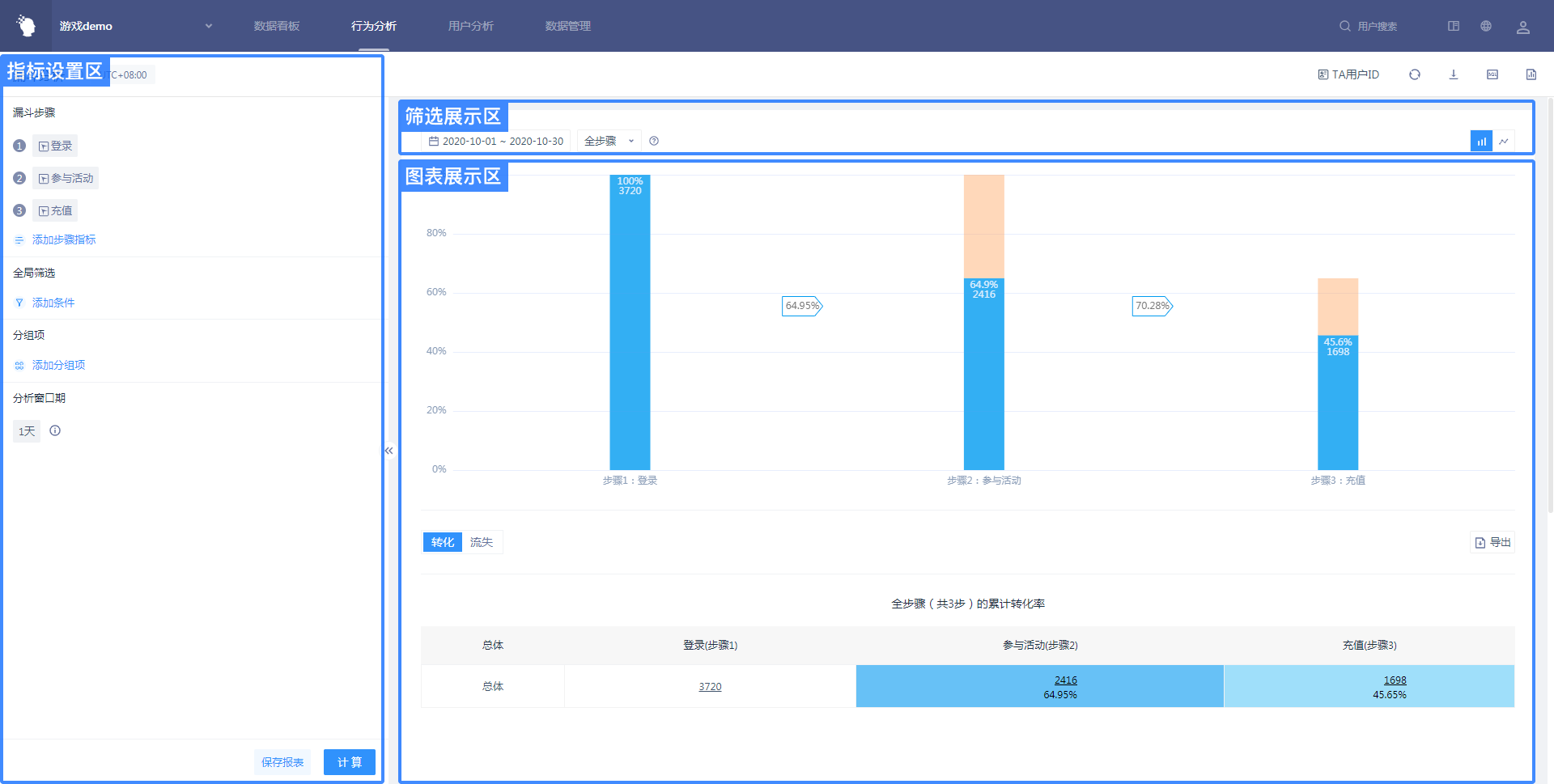
- Set 'analysis steps, group method, analysis window period' in 'indicator setting area'.
- Set 'analysis time period, analysis steps, group settings, chart style' in 'filter area'
- In the 'chart area', you can move the mouse to select a group object to view the details and 'one-step conversion' for each step.
- You can view the funnel data information of all groups in the 'table details area'.
# IV. Usage Scenarios of Funnel Analysis
# 4.1 Setting of Indicator Setting Area
# 4.1.1 Setting of Indicator Setting Area
By default:
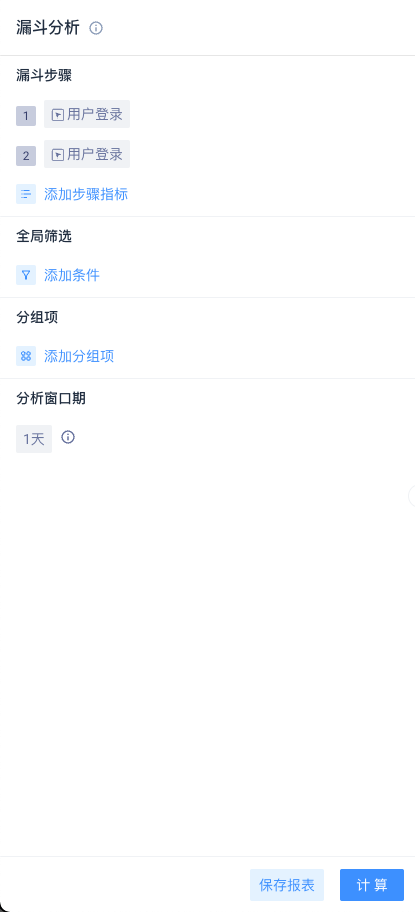
- The 'funnel step' is a two-step process, which is two events in metadata management and can be switched between selecting an event (no arbitrary event can be selected) and adding a step.
- 'Global Filter' can filter event attributes or user features common to all steps , user clusters and user tags.
- 'Group items' defaults to null, i.e. it is not grouped and can be added from step 1 of the event properties, user features, user groups and user tags.
- By default, the Analysis Window Period is 1 day, and you can select a custom window period by day, hour and minute in the drop-down box.
# 4.1.2 Add, Delete and Filter Conditions of Analysis Steps
- You can insert a new step through the 'Add Step Indicator' button , or move the mouse into the '+' of a step, or click on the copy step, you can add up to 30 steps.
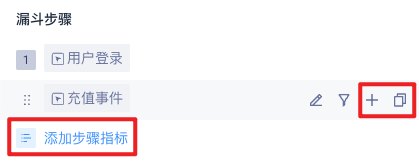
- You can move the mouse into the 'delete button' of a certain step and click to delete the step. After deleting, the serial numbers of other steps will change accordingly. In addition, when there are only 2 steps, the 'delete button' will not be shown.
- You can move the mouse into the 'filter conditions' of a certain step and click on 'increase the filter conditions'. The logic of adding, deleting and modifying the filter conditions is consistent with the event analysis.
# 4.1.3 Definition of Analysis Window Period
Analysis window period i.e., the user to trigger step 1 as a sample, the total analysis time range from the start of the trigger step 1, each user's analysis window length is fixed, but due to the different time points of the trigger step 1, the start and end of the funnel absolute date may be different .
# 4.2 Display of Filter Area Settings
# 4.2.1 Default Initial Page
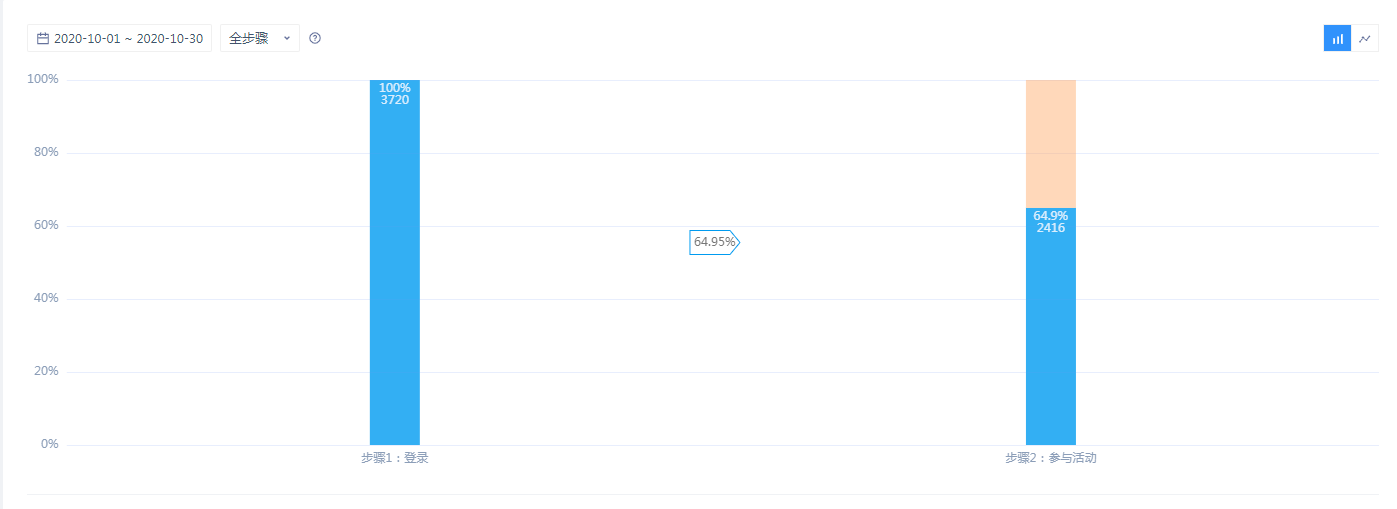
# 4.2.2 Definition of Analysis Period
The analysis period determines the selection interval of 'trigger time of step 1', and the dropdown menu is the same as event analysis.
# 4.2.3 Step Checkbox Operation
The step checkbox selects all steps by default, or step by step from Step M to Step N.
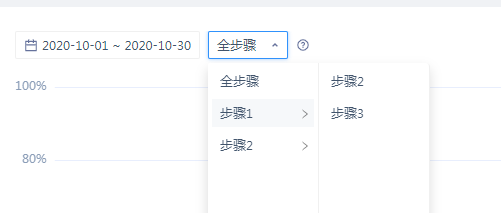
# 4.2.4 Group Settings
Chart settings are different from event analysis and always appear in the first item of the grouping.
When group sets more values, the default is to select the most 4 groups, up to 4 groups can be selected.
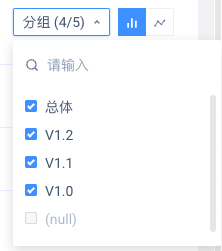
# 4.2.5 Download Data
The download data is the same as the table.
# 4.3 Display of Chart Area Settings
# 4.3.1 Content of Cumulative Transformation Funnel
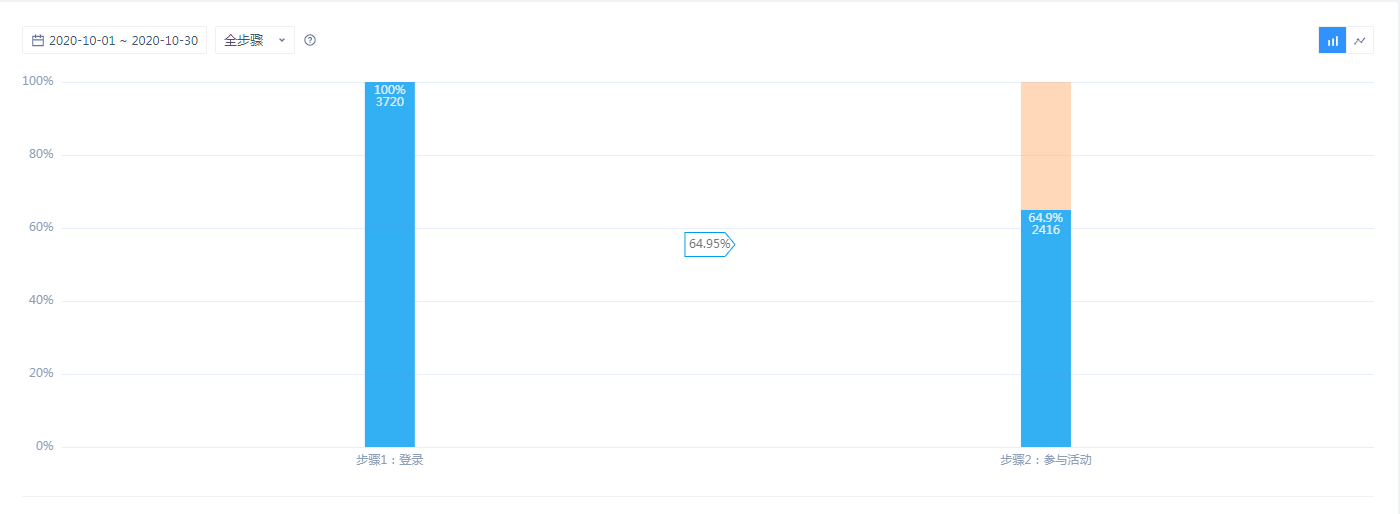
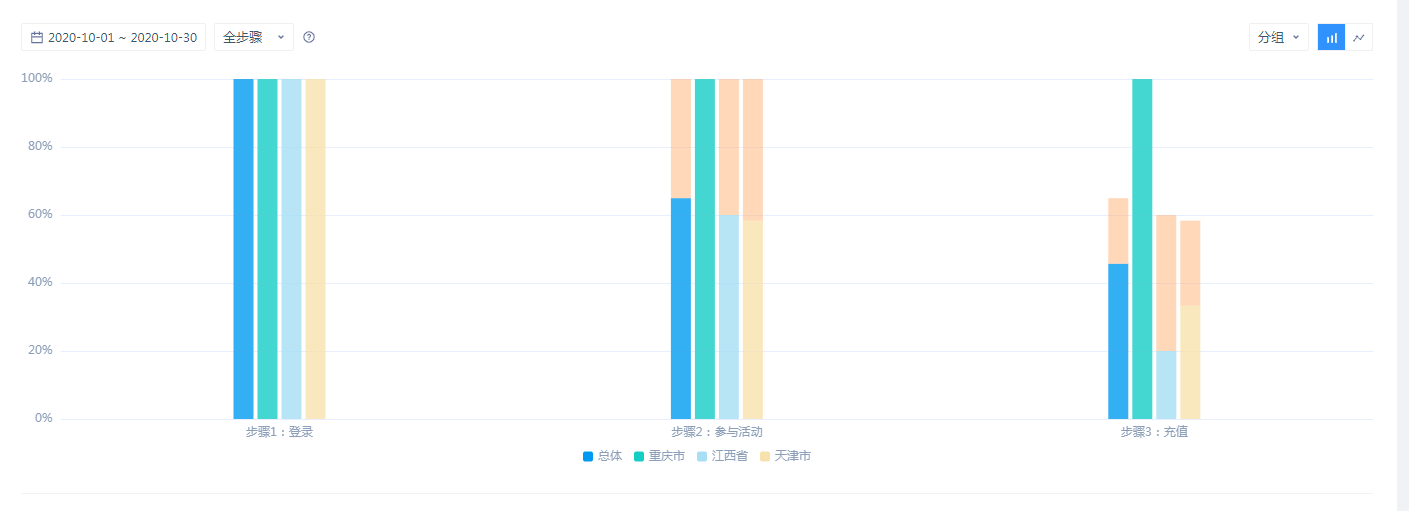
- Take the first step of the selected step as 100%, calculate the number of converters after each step and give the proportion.
- In the display of each step, the conversion rate of the previous step is represented by the background fill color.
- When the mouse moves in the grouped objects, the grouped objects are highlighted, showing the corresponding conversion rate, the number of converters, and the one-step conversion rate in the middle of each step (the color is the same as the grouped moved in).
# 4.3.2 Content of Transformation Trend Chart
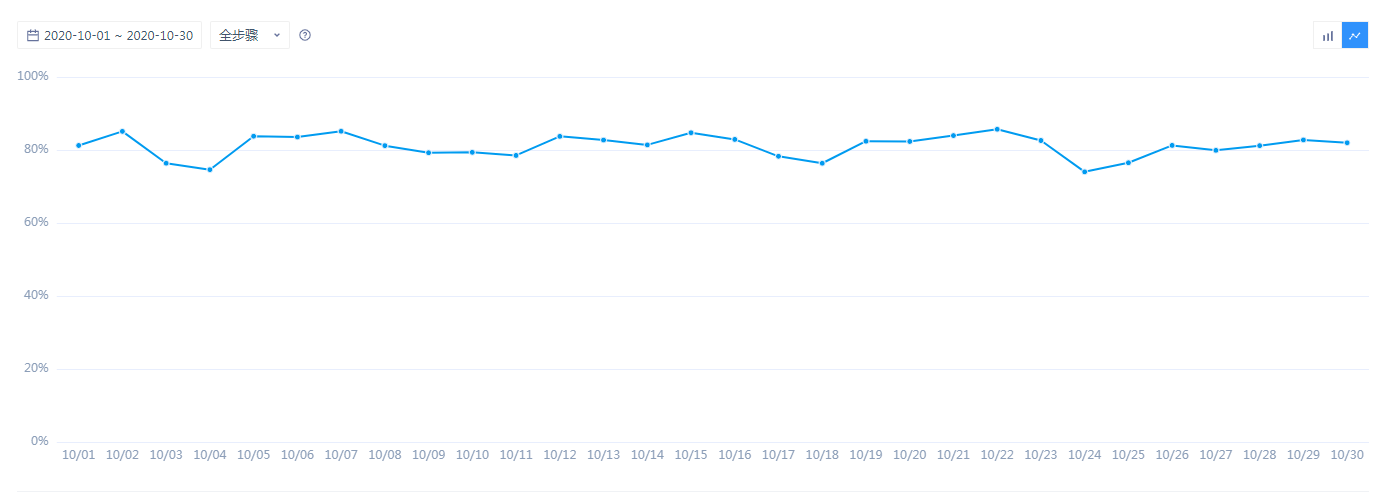
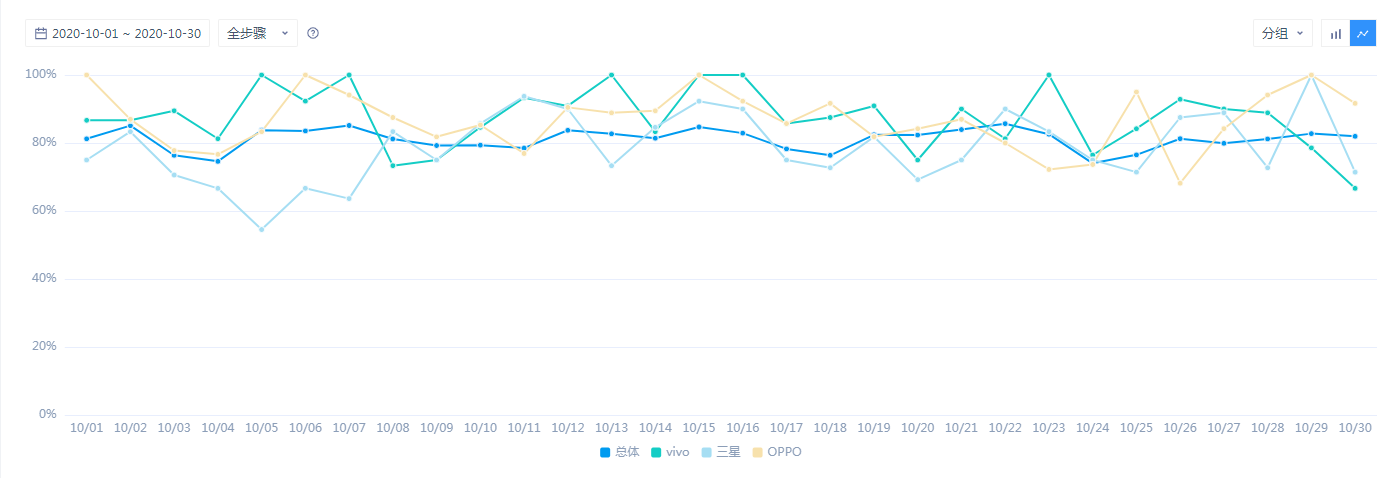
Take the first step of the selected step as 100%, and calculate the daily conversion rate from the beginning of the step to the last step of the selected step.
# 4.4 Setting of Form Details Area
# 4.4.1 Table Content of Transformation Diagram

Display all groupings (including the population and all possible groups, up to 1000 items), show the cumulative conversion rate at each step, and indicate it in color (similar to retention table).
# 4.4.2 Table Content of Trend Charts

# 4.5 Data Selection Instructions
# 4.5.1 Definition of Full Funnel
Assuming that a funnel contains five steps A, B, C, D, E, the selected time range is January 1, 2018 to January 3, 2018, and the window period is 1 day, then if the user triggers step A from January 1, 2018 to January 3, 2018, and in step Within 1 day of the occurrence of A (that is, if A is triggered on January 3, the subsequent steps can be extended to January 4), B, C, D, and E are triggered in sequence, and the user is deemed to have completed a complete full funnel conversion.
Similarly, if the original funnel is still selected to view the transformation of the specified steps, it is equivalent to intercepting a part of the funnel for subdivision.
# 4.5.2 Interspersed with Other Steps, also Counted as Completing the Conversion
In this process, if some other steps or behaviors are interspersed, for example, when the time limit is met, the user's behavior order is A > X > B > X > C > D > X > E, and X represents any event (including repeated A~ E), then the user is still regarded as having completed a successful funnel transformation.
# 4.5.3 Not Completed in Sequence, Will Not be Regarded as the Completion of Conversion
If the user within the event limits, in turn triggered A > B > C > E > D, the user does not complete the conversion of the funnel, and will be referred to as a loss user in step D.
# 4.5.4 First Complete as a Calculation Record when Multiple Transformations are Completed
If a user has multiple batches of events within the selected period that meet the definition of a certain conversion step, the event closer to the final conversion goal will be preferred as the conversion event, and the conversion calculation will be stopped when the final conversion goal is reached for the first time.
Still using the five steps A, B, C, D, and E as the standard, the behavior sequence of a certain user is as follows:
| Behavioral sequence | 1 | 2 | 3 | 4 | 5 | 6 | 7 | 8 | 9 | 10 |
|---|---|---|---|---|---|---|---|---|---|---|
| Behavioral events | A | B | A | D | B | C | E | D | C | B |
- Since there is no complete A > B > C > D > E process, continue to judge whether the sequence of A > B > C > D is satisfied。
- There are 3 sequences that satisfy A > B > C > D, and the behavior sequence that achieves transformation for the first time is obtained, namely:
| Behavioral sequence | 1 | 2 | 6 | 8 |
|---|---|---|---|---|
| Behavioral events | A | B | C | D |
The user is lost in step D, and the 4-step conversion of A~ D is completed, and the calculated serial numbers are 1,2,6,8 respectively.
# V. Best Applications
# 5.1 New User Conversion Funnel
The conversion funnel for new users is a very important analysis index. Under normal circumstances, the conversion process for new users will be determined at the product planning stage, which mainly consists of installation, registration, login, beginner's guide, retention, ice breaking, payment and other steps. In such a conversion process, the corresponding event can be set as each step of the funnel in the funnel analysis, so as to obtain the conversion funnel of new users, understand the overall conversion rate and the conversion rate of each step, locate the weak links in the conversion for optimization, or evaluate the user conversion of each source channel, so as to optimize the delivery strategy.
